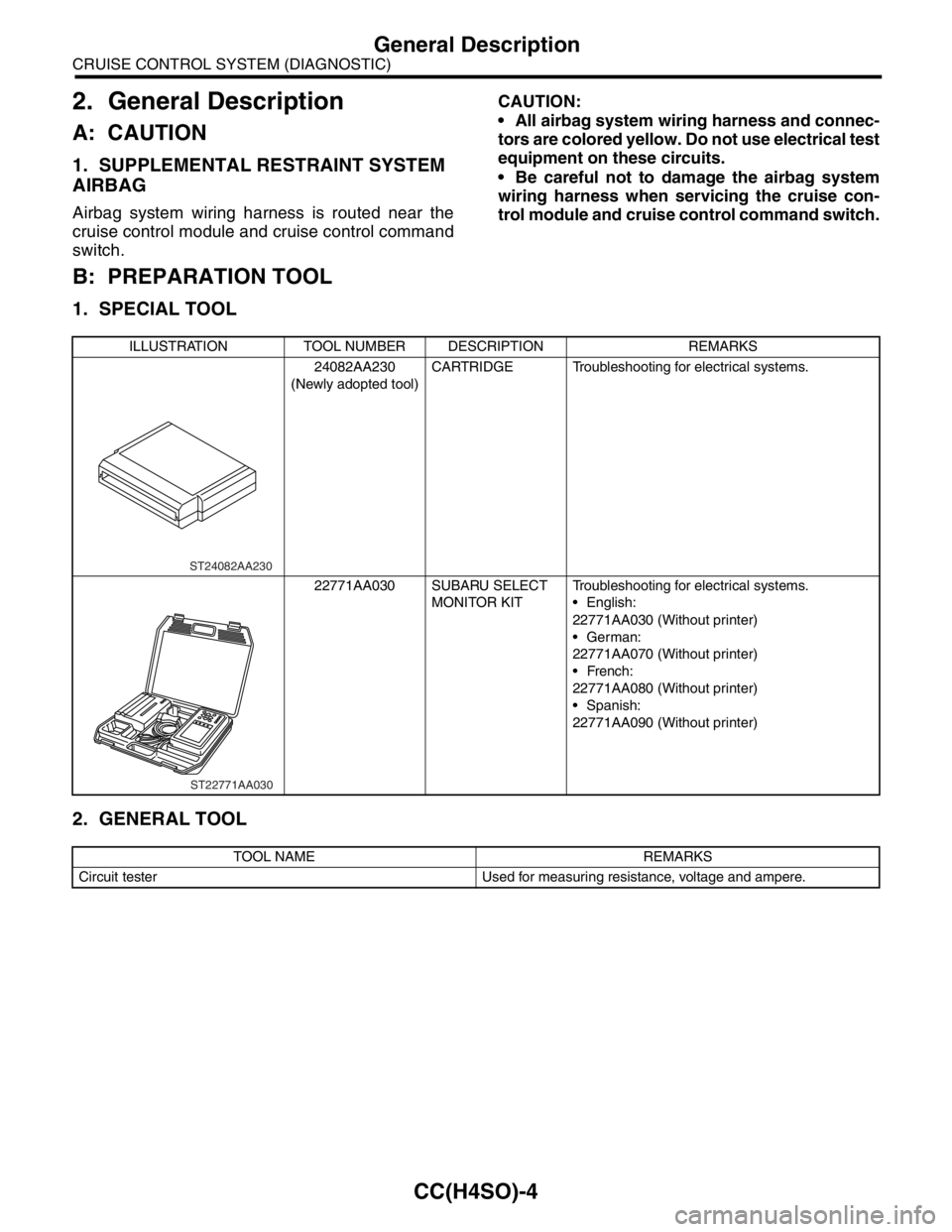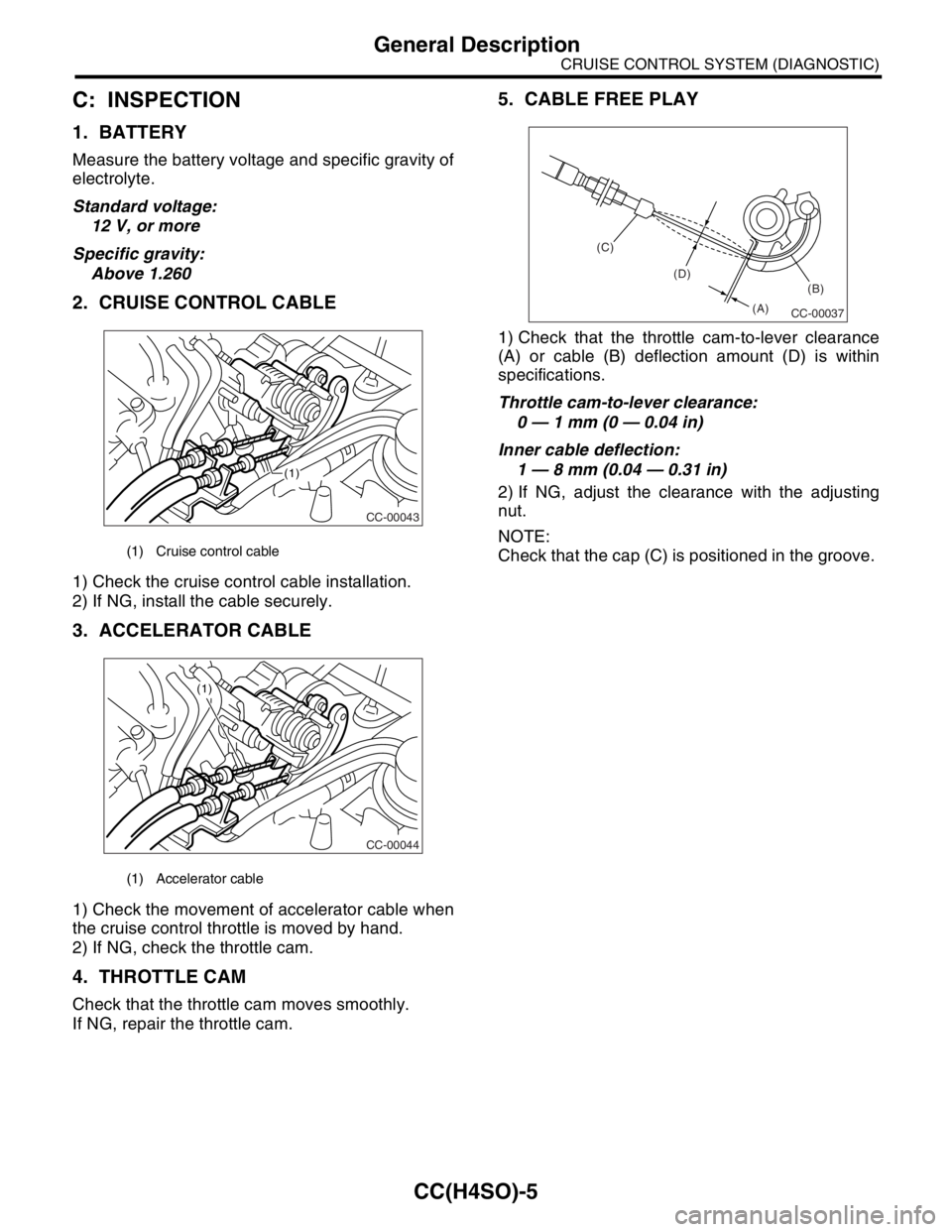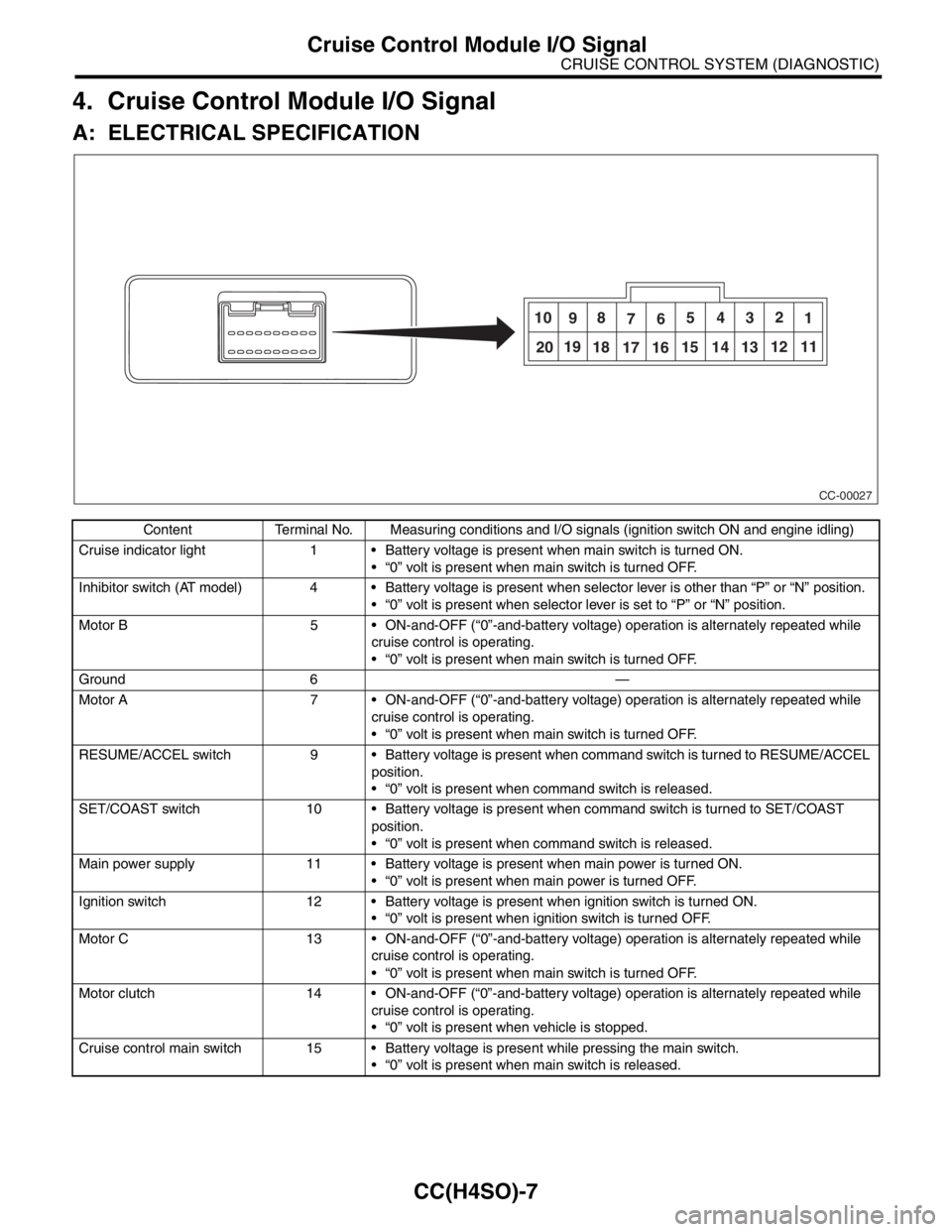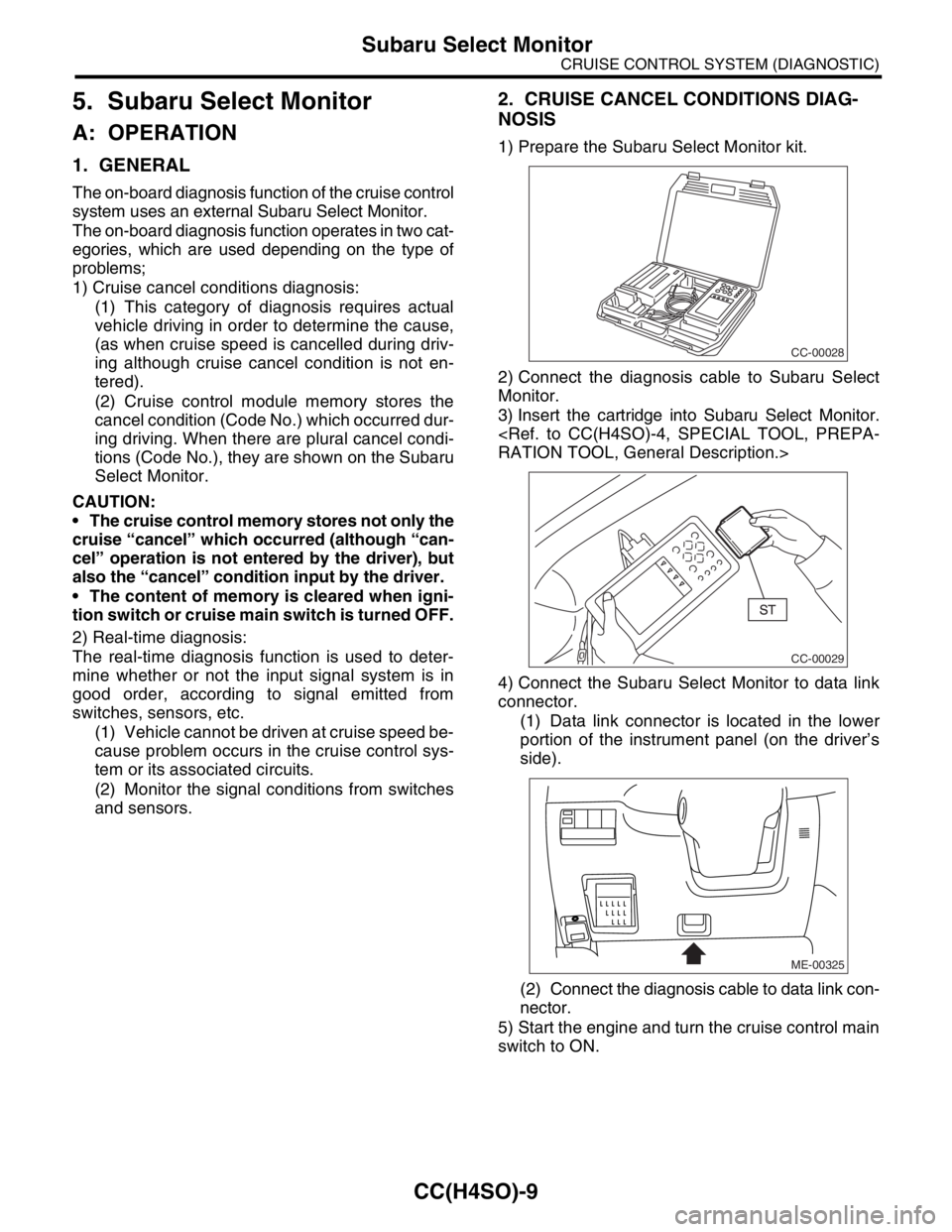SUBARU FORESTER 2004 Service Repair Manual
Manufacturer: SUBARU, Model Year: 2004, Model line: FORESTER, Model: SUBARU FORESTER 2004Pages: 2870, PDF Size: 38.67 MB
Page 571 of 2870

CC(H4SO)-3
CRUISE CONTROL SYSTEM (DIAGNOSTIC)
Basic Diagnostic Procedure
9 CHECK CRUISE CONTROL RELEASE OP-
ERATION.
Check the cruise control release operation.Is the cruise control released
after brake pedal has been
depressed?Go to step 10.Go to symptom 7.
SYMPTOM
CHART, Diagnos-
tic Procedure with
Symptom.>
10 CHECK CRUISE CONTROL RELEASE OP-
ERATION.
Check the cruise control release operation. Is the cruise control released
after clutch pedal has been
depressed? (MT model) Finish the diag-
nostics. Go to symptom 8.
SYMPTOM
CHART, Diagnos-
tic Procedure with
Symptom.> Step Check Yes No
Page 572 of 2870

CC(H4SO)-4
CRUISE CONTROL SYSTEM (DIAGNOSTIC)
General Description
2. General Description
A: CAUTION
1. SUPPLEMENTAL RESTRAINT SYSTEM
AIRBAG
Airbag system wiring harness is routed near the
cruise control module and cruise control command
switch.CAUTION:
All airbag system wiring harness and connec-
tors are colored yellow. Do not use electrical test
equipment on these circuits.
Be careful not to damage the airbag system
wiring harness when servicing the cruise con-
trol module and cruise control command switch.
B: PREPARATION TOOL
1. SPECIAL TOOL
2. GENERAL TOOL
ILLUSTRATION TOOL NUMBER DESCRIPTION REMARKS
24082AA230
(Newly adopted tool)CARTRIDGE Troubleshooting for electrical systems.
22771AA030 SUBARU SELECT
MONITOR KITTroubleshooting for electrical systems.
English:
22771AA030 (Without printer)
German:
22771AA070 (Without printer)
French:
22771AA080 (Without printer)
Spanish:
22771AA090 (Without printer)
TOOL NAME REMARKS
Circuit tester Used for measuring resistance, voltage and ampere.
ST24082AA230
ST22771AA030
Page 573 of 2870

CC(H4SO)-5
CRUISE CONTROL SYSTEM (DIAGNOSTIC)
General Description
C: INSPECTION
1. BATTERY
Measure the battery voltage and specific gravity of
electrolyte.
Standard voltage:
12 V, or more
Specific gravity:
Above 1.260
2. CRUISE CONTROL CABLE
1) Check the cruise control cable installation.
2) If NG, install the cable securely.
3. ACCELERATOR CABLE
1) Check the movement of accelerator cable when
the cruise control throttle is moved by hand.
2) If NG, check the throttle cam.
4. THROTTLE CAM
Check that the throttle cam moves smoothly.
If NG, repair the throttle cam.
5. CABLE FREE PLAY
1) Check that the throttle cam-to-lever clearance
(A) or cable (B) deflection amount (D) is within
specifications.
Throttle cam-to-lever clearance:
0 — 1 mm (0 — 0.04 in)
Inner cable deflection:
1 — 8 mm (0.04 — 0.31 in)
2) If NG, adjust the clearance with the adjusting
nut.
NOTE:
Check that the cap (C) is positioned in the groove.
(1) Cruise control cable
(1) Accelerator cable
CC-00043
(1)
CC-00044
(1)
CC-00037
(B)
(A) (D) (C)
Page 574 of 2870

CC(H4SO)-6
CRUISE CONTROL SYSTEM (DIAGNOSTIC)
Electrical Components Location
3. Electrical Components Location
A: LOCATION
(1) Actuator (4) Cruise control main switch (7) Cruise control module
(2) Inhibitor switch (AT model) (5) Clutch switch (MT model)
(3) Cruise control command switch (6) Stop and brake switch
(1)(2)
(3)
(4)
(5)
(6)
(7)
CC-00001
Page 575 of 2870

CC(H4SO)-7
CRUISE CONTROL SYSTEM (DIAGNOSTIC)
Cruise Control Module I/O Signal
4. Cruise Control Module I/O Signal
A: ELECTRICAL SPECIFICATION
Content Terminal No. Measuring conditions and I/O signals (ignition switch ON and engine idling)
Cruise indicator light 1 Battery voltage is present when main switch is turned ON.
“0” volt is present when main switch is turned OFF.
Inhibitor switch (AT model) 4 Battery voltage is present when selector lever is other than “P” or “N” position.
“0” volt is present when selector lever is set to “P” or “N” position.
Motor B 5 ON-and-OFF (“0”-and-battery voltage) operation is alternately repeated while
cruise control is operating.
“0” volt is present when main switch is turned OFF.
Ground 6 —
Motor A 7 ON-and-OFF (“0”-and-battery voltage) operation is alternately repeated while
cruise control is operating.
“0” volt is present when main switch is turned OFF.
RESUME/ACCEL switch 9 Battery voltage is present when command switch is turned to RESUME/ACCEL
position.
“0” volt is present when command switch is released.
SET/COAST switch 10 Battery voltage is present when command switch is turned to SET/COAST
position.
“0” volt is present when command switch is released.
Main power supply 11 Battery voltage is present when main power is turned ON.
“0” volt is present when main power is turned OFF.
Ignition switch 12 Battery voltage is present when ignition switch is turned ON.
“0” volt is present when ignition switch is turned OFF.
Motor C 13 ON-and-OFF (“0”-and-battery voltage) operation is alternately repeated while
cruise control is operating.
“0” volt is present when main switch is turned OFF.
Motor clutch 14 ON-and-OFF (“0”-and-battery voltage) operation is alternately repeated while
cruise control is operating.
“0” volt is present when vehicle is stopped.
Cruise control main switch 15 Battery voltage is present while pressing the main switch.
“0” volt is present when main switch is released.
CC-00027
10
98
765432
1
2019
18
17 1615 14 1312 11
Page 576 of 2870

CC(H4SO)-8
CRUISE CONTROL SYSTEM (DIAGNOSTIC)
Cruise Control Module I/O Signal
B: WIRING DIAGRAM
Brake switch/Clutch switch
(MT model)16 Leave clutch pedal released (MT model), while cruise control main switch is
turned ON.
Then check that;
Battery voltage is present when brake pedal is released.
“0” volt is present when brake pedal is depressed.
Additionally only in MT model, keep the cruise control main switch to ON and
leave brake pedal released.
Then check that;
Battery voltage is present when clutch pedal is released.
“0” volt is present when clutch pedal is depressed.
Data link connector 17 —
Data link connector 18 —
Vehicle speed sensor (MT
model)
TCM (AT model)19 Lift-up the vehicle until all four wheels are raised off ground, and then rotate any
wheel manually.
Approx. “5” and “0” volt pulse signals are alternately input to cruise control mod-
ule.
Stop light switch 20 Turn ignition switch to OFF.
Then check that;
Battery voltage is present when brake pedal is depressed.
“0” volt is present when brake pedal is released.
NOTE:
Voltage at terminals 5, 7, 13 and 14 cannot be checked unless vehicle is driving by cruise control operation.Content Terminal No. Measuring conditions and I/O signals (ignition switch ON and engine idling)
Page 577 of 2870

CC(H4SO)-9
CRUISE CONTROL SYSTEM (DIAGNOSTIC)
Subaru Select Monitor
5. Subaru Select Monitor
A: OPERATION
1. GENERAL
The on-board diagnosis function of the cruise control
system uses an external Subaru Select Monitor.
The on-board diagnosis function operates in two cat-
egories, which are used depending on the type of
problems;
1) Cruise cancel conditions diagnosis:
(1) This category of diagnosis requires actual
vehicle driving in order to determine the cause,
(as when cruise speed is cancelled during driv-
ing although cruise cancel condition is not en-
tered).
(2) Cruise control module memory stores the
cancel condition (Code No.) which occurred dur-
ing driving. When there are plural cancel condi-
tions (Code No.), they are shown on the Subaru
Select Monitor.
CAUTION:
The cruise control memory stores not only the
cruise “cancel” which occurred (although “can-
cel” operation is not entered by the driver), but
also the “cancel” condition input by the driver.
The content of memory is cleared when igni-
tion switch or cruise main switch is turned OFF.
2) Real-time diagnosis:
The real-time diagnosis function is used to deter-
mine whether or not the input signal system is in
good order, according to signal emitted from
switches, sensors, etc.
(1) Vehicle cannot be driven at cruise speed be-
cause problem occurs in the cruise control sys-
tem or its associated circuits.
(2) Monitor the signal conditions from switches
and sensors.
2. CRUISE CANCEL CONDITIONS DIAG-
NOSIS
1) Prepare the Subaru Select Monitor kit.
2) Connect the diagnosis cable to Subaru Select
Monitor.
3) Insert the cartridge into Subaru Select Monitor.
4) Connect the Subaru Select Monitor to data link
connector.
(1) Data link connector is located in the lower
portion of the instrument panel (on the driver’s
side).
(2) Connect the diagnosis cable to data link con-
nector.
5) Start the engine and turn the cruise control main
switch to ON.
CC-00028
CC-00029
ME-00325
Page 578 of 2870

CC(H4SO)-10
CRUISE CONTROL SYSTEM (DIAGNOSTIC)
Subaru Select Monitor
6) Turn the Subaru Select Monitor switch to ON.
7) On the Main Menu display screen, select the {All
System Diagnosis} and press [YES] key.
NOTE:
DTC is also shown in the {Each System Check} mode.
This mode is called up on the Cruise Control Diagnosis
screen by selecting the item {Cancel Code(s) Display}.
8) Drive the vehicle at least 30 km/h (19 MPH) with
cruise speed set.
9) If the cruise speed is canceled itself (without do-
ing any cancel operations), DTC will appear on se-
lect monitor display.
CAUTION:
DTC will also appear when cruise cancel is ef-
fected by driver. Do not confuse.
Have a co-worker ride in the vehicle to assist
in diagnosis during driving.
NOTE:
DTC will be cleared by turning the ignition switch or
cruise control main switch to OFF.3. REAL-TIME DIAGNOSIS
1) Connect the select monitor.
2) Turn the ignition switch and cruise control main
switch to ON.
3) Turn the Subaru Select Monitor switch to ON.
4) On the Main Menu display screen, select the
{Each System Check} and press [YES] key.
5) On the System Selection Menu display screen,
select the {Cruise Control} and press [YES] key.
6) Press the [YES] key after displayed the informa-
tion of engine type.
7) On the Cruise Control Diagnosis display screen,
select the {Current Data Display & Save} and press
[YES] key.
8) Make sure that normal indication is displayed
when controls are operated as indicated below:
Depress/release the brake pedal. (Stop light
switch and brake switch turn ON or OFF.)
Turn ON or OFF the “SET/COAST” switch.
Turn ON or OFF the “RESUME/ACCEL” switch.
Depress/release the clutch pedal. (MT model)
Set the selector lever to P or N. (AT model)
NOTE:
For detailed operation procedure, refer to the
SUBARU SELECT MONITOR OPERATION MAN-
UAL.
For detailed concerning DTC, refer to the List of
Diagnostic Trouble Code (DTC).
(1) Power switch
CC-00045
(1)
Page 579 of 2870

CC(H4SO)-11
CRUISE CONTROL SYSTEM (DIAGNOSTIC)
Diagnostic Procedure with Symptom
6. Diagnostic Procedure with Symptom
A: SYMPTOM CHART
Symptom Repair area Reference
1Cruise control main switch is
not turned ON. (1) Check the power supply.
(2) Check the cruise control
main switch.
2Cruise indicator light does not
illuminate.Check the cruise indicator
light.
3Cruise control cannot be set. (1) Check the SET/COAST
switch.
tom.>
(2) Check the stop light switch
and brake switch.
tom.>
(3) Check the clutch switch
(MT model).
(4) Check the inhibitor switch
(AT model).
(5) Check the vehicle speed
sensor.
Code (DTC).>
(6) Check the motor drive
system.
Code (DTC).>
(7) Check the motor clutch
drive system.
Code (DTC).>
4Vehicle speed is not held
within set speed ±3 km/h (±2
MPH). (1) Check the vehicle speed
sensor.
Code (DTC).>
(2) Check the motor drive
system.
Code (DTC).>
(3) Check the motor clutch
drive system.
Code (DTC).>
5Vehicle speed does not
increase or does not return to
set speed after RESUME/
ACCEL switch has been
pressed.(1) Check the RESUME/
AC CEL switch.
tom.>
(2) Check the motor drive
system.
Code (DTC).>
(3) Check the motor clutch
drive system.
Code (DTC).>
6Vehicle speed does not
decrease after SET/COAST
switch has been pressed. (1) Check the SET/COAST
switch.
tom.>
(2) Check the motor drive
system.
Code (DTC).>
(3) Check the motor clutch
drive system.
Code (DTC).>
Page 580 of 2870

CC(H4SO)-12
CRUISE CONTROL SYSTEM (DIAGNOSTIC)
Diagnostic Procedure with Symptom
7Cruise control is not released
after CANCEL switch has
been pressed. (1) Check the CANCEL
switch.
tom.>
(2) Check the motor drive
system.
Code (DTC).>
(3) Check the motor clutch
drive system.
Code (DTC).>
8Cruise control is not released
after brake pedal has been
depressed. (1) Check the stop light switch
and brake switch.
tom.>
(2) Check the motor drive
system.
Code (DTC).>
(3) Check the motor clutch
drive system.
Code (DTC).>
9Cruise control is not released
after clutch pedal has been
depressed (MT model). (1) Check the clutch switch.
(2) Check the motor drive
system.
Code (DTC).>
(3) Check the motor clutch
drive system.
Code (DTC).> Symptom Repair area Reference